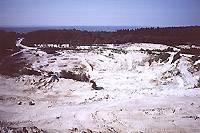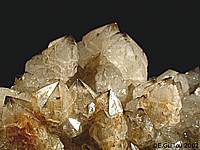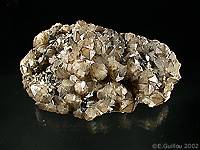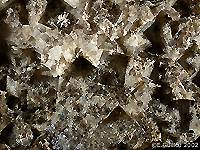|
|
THE KAOLIN VEIN Of ECHASSIERES
Geographical situation,
regional and historical geology of the quarry
Kaolin exploitation of Beauvoir is located to approximately 50 km from the North
of Clermont-Ferrand not far from the Echassieres village in the department of
Allier.
The ore deposit is located meadows of the known carboniferous furrow
for its many coal veins in the department of Allier (Commentry, Saint-Eloy..)
and of Puy-de-Dome (Messeix, Brassac).
The Echassieres site is remarkable
by her mineralogical richness like by the geological context complexes ore deposit.
If the genesis of kaolinite is known, the origine of certain mineralisations as
wolframite is less obvious.
The
company of the kaolins of Beauvoir (SKB) exploits the kaolin since 1894. Four
old other companies were interested in the quarry (James kaolins) but only the
SKB resisted competition.
For 10 years, this company has reached an industrial
stage thanks to the repurchase by COFRAMINE (subsidiary of the BRGM). It is currently
the Australian company Normandy Poseidon which invests in this sector.
General
According to the data of experimental petrology, the Echassieres complex gathers
two granites:
- granite of Colettes
- granite of Beauvoir
This ore
deposit is located in the opposite series cristallophilienne of Sioule, metamorphic
series made up of compound gneisses, gneiss, schists and especially of mica schists
on the level of the quarry of Beauvoir.

Overall view of the quarry of Echassieres
With the end of Primary era, granitic the intrusion of a batholite (granite of Colettes) caused a metamorphism of contact to andalusite and cordierite in mica schists already affected by a regional metamorphism to two micas, staurolite and sillimanite. This granite was recut by the granite of Beauvoir.
These intrusions seem to be anteviseennes! The granite of Colettes was considered at 305 millions years old +/- 4 millions thanks to the method of dating rubidium/strontium applied to lepidolites.
The granite of Beauvoir is from the metallogenic point of view more interessant because it presents three facies showing an enrichment out of rare earths.
Description of the granitic complex.
Granite of ColettesIt is a porphyroide granite with two micas not very faded, compact, about 15km², whose mineralogical composition is characterized by the presence of cordierite; its dew color is due to an important content of iron.
This granite is not specialized !
The study of fluid inclusions in quartz made possible to establish a depth of installation from 5 to 6 kmGranite of Beauvoir
With a good amount of topaz and lepidolite, white feldspar, the granite of Beauvoir is a granite hololeucocrat because of his absence of biotite.
Its extension is around 15 hectares and its depth of installation is estimated at 3 kilometers.
Its high content in Lithium, Nobium and Tantale is concretized by lepidolite and colombo-tantalite apparition. This granitic blade consists of 3 superimposed units. This evolution is characteristic of a specialized granite.
A specialized granite is a granite having sudden a pushed split crystallization. It means that the incompatible elements such as Li, F, Sn concentrate in the liquid phase. The deposit will crystallize to give an advanced granite enriched out of lepidolite (Li), apatite (F), cassiterite (Sn).
In a triangle quartz, white feldspar, orthoclase, one notices that when the fluorite and lithium crystallize in topazes and lepidolites, the chemical composition of the granite evolves to the pole white feldspar. Split crystallization occurs when lowers temperatures appear.
This magmatic differentiation was confirmed at the time of the realization
of the survey of 900m (Echassieres 1), left the program "Major Geology of France".
It highlighted the increased concentration in lithophiles elements (F, Li, Be)
occured to the top of the granitic cupola.
In the mica schists, one notes a chemical zonality materialized by appraimpoverishment out of Lithium and fluorite when we leave the batholite! In addition, these mica schists underwent a polyphase hydrothermalism in the form of ore deposits and impregnations in As, Li, F, Rb.

![]()

Constitution of Echassieres Kaolin deposit
This deposit results from the destruction of the granitic complex. This deterioration results in two important phenomenas:
- the greisenisation
- kaolinization
These two processes, coupled with the composition even of the granites, make that the site of Echassieres is exploitable; kaolinization has as consequence the kaolin formation and the greisenisation supporting the development of cassiterite.
The greisenisation
The greisenisation is the result of granite silicification by the action
of pneumatolithic fluids intervening just after the installation of the
granite.
The rock obtained is a greisen (german ethymology), grey stein (grey
stone), rock made up of quartz and muscovite (which differs from the granite by
absence feldspar).
To arrive at this result, it is necessary to plan hydrolysis of feldspars, in particular with albite: by considering the following reactions:
3 KAlSi3O8 + 2H+aq < = KAl3If3O10(OH)2 + 6 SiO2 + 2 K+aq
Potassic feldspar = > muscovite3 NaAlSi3O8 + 2H+aq < = NaAl3If3O10(OH)2 + 6 SiO2 + 2 Na+aq
Sodic white feldspar = > Mica
In conclusion:
White feldspar + H+ + K+ = > Muscovite + SiO2 + Na+
< =
There is thus scrubbing of alkaline, in particular Sodium. Thus, it is necessary
to introduce into the system a fluid which intervenes in the deposit by the means
of fractures induced by an increase in the pressure of fluid.
We note a system of parallel fractures between them that are filled with quartz with to their immediate strata, of the greisens.
Thanks to the fluid inclusions studied in quartz which "fossilizes" the fluid
responsible for alteration, one deduces the composition from it from the fluid
like his temperature. It results from it that the starting fluid is less aggressive;
it is in balance with potassic feldspar and albite then it progressively becomes
increasingly acid with circulation to be in balance with potassic muscovite and
Sodique muscovite.
The temperature is estimated at 400C for a pH 3,5/5.
Kaolinization
The Echasssieres ore deposit is exploited above all for the kaolin; the kaolin being an industrial term, one will speak more rigorously about kaolinite (Si4O10Al2(OH)8)
Kaolinite is a phyllosilicate characterized by its white color and its structure
in vein.
One distinguishes 2 modes from formation of kaolinite:
Incongruent dissolution successively from the potassic stage feldspar, muscovite then kaolinite. It's hydrolysis.
Congruent dissolution where the fluid formed starting from potassic feldspars contains the various elements necessary to the manufacture of kaolinite.
However, to be formed, kaolinite must deal with certain chemical constraints:
- Its formation depends on the stoechiometric proportion in Si et Al.
- If Al=Si, kaolinite precipitates quickly
- If silica is in excess, it is formed silica cryptocristalline then of kaolinite when the conditions reach the chemical equilibrium.
- If Al is in excess, the gibbsite is formed to leave the place with chemical balance with kaolinite.
- the second obstacle resides in the alkalin presence (Na and K). The latter come from the dissolution of potassic feldspar and mostly the precipitation of kaolinite. It is thus necessary to consider important fluids circulation and renewed to be able progressively to eliminate the alkaline ones with kaolinization.
It results from it that to obtain a kaolinite vein, one needs a solution for acid pH and a drainage of the solution that promote mineralisation. The content of kaolinite of the rock is governed by the proportion of feldspar; the latter is around 40% for the Echassieres ore deposit.
Kaolinization is not, in any case, homogeneous.
In the quarries exploited
by the SKB, we see with the granite of Colettes that is very kaolinized
because of the homogeneity of the starting granite whereas the granite of Beauvoir
is subjected to a more irregular deterioration induced by the presence of veins
of greisens which resist better to alteration .
Except these observations
made on the visible part of the deposit, we discovered that the kaolinized zone
is along quartz until a limiting depth of 50m. Certain parts of the deposit are
not kaolinized. It is the case of the veins of greisens and of certain granite
zones of Beauvoir, the stone.
The conditions of genesis of kaolinite in an environment supergene is about 25C
whereas kaolinite with hydrothermal origin, even pneumatolytic origin, is about
200C. This makes it possible to suppose 2 modes of formation of the kaolinite
including one by meteoric water action which is completely possible under our
lattitudes.
The heterogeneity of the ore deposit leaves think that the two
phenomena are superimposed. Initially, the intervention of the pneumatolytic fluids
prefabricate kaolinite and then, meteorics. The action of water completes the
process. Indeed, if we look only the pneumatolytic fluids, the deposit would not
be so wide. Kaolinization would have affected the immediate strata of the draining
seams. We need a supergene process on a material already strongly faded to obtain
a such deposit.
Considering the conditions of formation of kaolinite, the
paleoclimate was to be subtropical but a beginning of kaolinization can be obtained
under our climates at the end of 5 years (if the preceding conditions are necessary).
The age of kaolinization is not well- known.
Echassieres enigma...
In
the southern zone of the quarry, on the level of the micaschisteuse cover which
borders the granite of Beauvoir, the old site of the montmins testifies to an
exploitation of quartz filonnets with wolframite. These mineralisations are recut
by the granite of Colettes and that of Beauvoir, which implies that wolfram is
former to the 2 granites and that its source is to be sought in a third granite.
The granite of "La Bosse" (bump!), not levelling, would be with the
origin of these mineralisations. This assumption failed to be confirmed by the
major survey campaign of France implemented since 1983.
Granitic studies
of geochemical and metallogenic evolution of Echassieres apex (top) was one of
the eleven projects adopted in program GPF.
With a length envisaged of 1000m,
the survey finally measured that 900m for lack of appropriations and served only
to prove the honest contact between the granite of Colettes and the granite of
Beauvoir.
Mineralogy of the ore deposit.
The list of minerals quoted below is the reflection of the lucky finds of these five last years. It will be thus summary and incomplete especially with regard to micro-minerals.
Smoked quartz.
Principal observable mineralisations in the ore deposit are quartz. Varied colours, it is however the smoked quartz which is most required. The crystals that we can currently find reach seldom more than 3 centimetres.
They are made up only of the pyramid, but certain crystals are developed and present a prism made up of multiple pyramids.
With regard to their glare, quartz is often covered rather recalcitrant oxydes with the light acids. Certain parts in are covered with a hardened clay, the gorceixite, rare clay only for the geologist the seams presenting of mineralisations are generally filled with a characteristic reddish clay.
Certain seams are brechik (chewed); this fact no sample can be extracted, one finds only pyramids insulated in mud.
The colour of quartz depends on the irradiation degree. The smoked colour is promoted by a replacement of the atoms of Si by Al, while starting with the edges. This can arrive at the stage morion.
Haematoid quartz.
A recent discovery updated haematoid quartz of a few centimetres, rather squat and associated lepidolite and cassiterite. Quartz has a whole a prism developed well with a phantom red colour. The latter comes from the transformation from iron oxides such as hematite or the goethite which are omnipresent in the ore deposit. We can find floating and finished on both extremities cristals (broken then recristallized) that can reach 5 cm.
Secondary turquoise and other minerals.
A quartzose seam delivered amorphous turquoise nodules going up to 20cm of diameter, associated cassiterite or wolframite in the cavernous parts. Other alteration products are frequently met without being for as much interesting (malachite, pyromorphite, plumbogummite...)
Some quartz seams with cavernous structure are filled with mud and show to geometrical structures characteristic of old crystals of fluorite. They are frequent traces of dissolution in the ore deposit.
All the visible seams in the faded granite are to be followed in the mica schist of the roof but the thickness of the seams decreases to the top of granitic apex. The only interesting mineralisation collected in the hydrothermalized mica schists are acicular hemimorphites measuring up to 1.5 cm, stacks some on smoked quartz of small size. The hemimorphite is of cream-coloured and not very transparent color. It represents other secondary mineralisations just like a polyphasage of mineralisations.
Scheelite was also found in the lower levels of the quarry.
Cassiterite and wolframite.
These two minerals are frequent in quarries related to the granites. The granite of Beauvoir has a crustal origin and, in spite of this, it didn't generate important mineralisations out of W and Sn what is however usual for the specialized granites.
It is noted that wolframite concentrates in the seams with the columbotantalite. This is explained by a W content solid lower than the content of W in the silicated liquid. Moreover, one high percentage of Cl and F in the liquid disadvantage the concentration of tungsten.
The explanation of absence of cassiterite in the granite of Beauvoir is not as simple as for wolframite. It is known that Sn is transported in form Sn2+ and crystallizes in form Sn4+. The oxydo-reduction conditions promote the apparition of SnO2. Sn absence in the granite of Beauvoir can be explained by a too strong fugacityout of O 2. In general, the specialized granites have a fugacity out of O2 weak, proof of the installation in reducing medium. Such a medium is characterized by the ilmenite presence (Iron in reduced form).
However in Echassiere, the granite of Beauvoir does not contain ilmenite. The report/ratio FeO/Fe2O3 drops when increases specialization; Fe2O3 (oxidized form) is thus dominating with the fur of enrichment in elements birds in the granite. This strong oxygen fugacity would explain the Sn crystallization in the magma; this is why cassiterite is especially found in the form of flies in the granite and more rarely out of well individualized crystals. LACROIX indeed quoted cassiterite only in millimetre-length form. Some centimetric samples in small lepidolite and quartz geodes were found.
Samples were found in the content of the quarry. A pegmatite seam delivered muscovite plates moreover ten cm. The majority of the crystals present the twin "in tin nozzle". If their size does not make them interesting, they are on the other hand very brilliant.
Mining economy of the
ore deposit.
The
reserves of the ore deposit are estimated at more than thirty years with 40 million
tons of reserves. The figure of affair the SKB is around 4 millions euros while
being centered on the kaolin and its by-products like cassiterite. Even if cassiterite
is not a concessible substance, it is all the same exploited as a by-product and
holds an important role in the economy of the ore deposit.
Four qualities
of kaolin are marketed according to their content of iron thus their purity.
Certain substances are not developed; i.e. the case of 50000 T lithium in
form Li2O contained in lepidolites of the ore deposit. This substance is generally
exploited and sold in amblygonite form in the other producing ore deposits. Thus,
it is American lithium of production that arrives on the market because the glass-makers,
beryllium and lithium users do not want to change their methods of transformation
who use amblygonite and phenacite (Be).
In the same way, 1800 T of tantalum in tantalite, 3000 T of BeO contained in Herderite (Be Ca PO4 (F, OH)) as 3 million tons albite are not developed.
Conclusion
The mineralogical richness of this ore deposit is not to be proven more but like the majority of the sites, their access is regulated! The entrance is indeed prohibited except exceptional authorization. This is explained by preoccupations with a safety which are real; the danger does not appear here by crumblings due to too unstable steps but especially in the content of the quarry where a zone is constantly drowned. The kaolin constitutes on this level a true danger.
Guillaume Mazankiewicz
| It should be noted that the site of Echassieres was added to SPATHFLUOR.COM because there is a close relationship with the fluorite. Indeed, at the time of last research, a smoked quartz plate had been found. This one rested on a rather hard kaolin gangue, and a chemical treatment enabled us to discover the back of crystallization: Just
like in Valzergues or Kaymar, of the prints of cubes are present. That thus means
the old presence of a cubic mineral which was dissolves, and which would have
been fluorite. Etienne Guillou |
